Human/Mouse/Rat Phospho-ERK1 (T202/Y204)/ERK2 (T185/Y187) Antibody
Human/Mouse/Rat Phospho-ERK1 (T202/Y204)/ERK2 (T185/Y187) Antibody Summary
Applications
Please Note: Optimal dilutions should be determined by each laboratory for each application. General Protocols are available in the Technical Information section on our website.
Scientific Data
 View Larger
View Larger
Detection of Mouse, Rat, and Human Phospho-ERK1 (T202/Y204) and ERK2 (T185/Y187) by Western Blot. Western blot shows lysates of NIH-3T3 mouse embryonic fibroblast cell line untreated (-) or treated (+) with 100 ng/mL Rabbit Anti-Human PDGF (Catalog # 120-HD) and PC-12 rat adrenal pheochromocytoma cell line untreated or treated with 100 ng/mL Recombinant Rat beta -NGF (Catalog # 556-NG) and HeLa human cervical epithelial carcinoma cell line untreated or treated with 200 nM PMA. PVDF membrane was probed with 0.5 µg/mL of Human/Mouse/Rat Phospho-ERK1 (T202/Y204)/ERK2 (T185/Y187) Monoclonal Antibody (MAB1018), followed by HRP-conjugated Anti-Rabbit IgG Secondary Antibody (Catalog # HAF008). Specific bands were detected for Phospho-ERK1 (T202/Y204)/ ERK2 (T185/Y187) at approximately 40-45 kDa (as indicated). This experiment was conducted under reducing conditions and using Immunoblot Buffer Group 3.
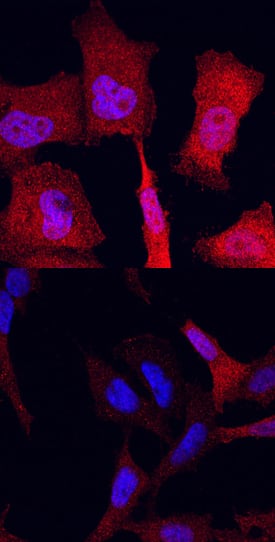 View Larger
View Larger
Phospho-ERK1 (T202/Y204)/ERK2 (T185/Y187) in HeLa Human Cell Line. ERK1/ERK2 phosphorylated at T202/Y204 (ERK1) and T185/Y187 (ERK2) was detected in immersion fixed Hela human cervical epithelial carcinoma cells, unstimulated (lower panel) and stimulated (upper panel) with PMA using Rabbit Anti-Human/Mouse/Rat Phospho-ERK1/ERK2 (ERK1 T202/Y204, ERK2 T185/Y187) Monoclonal Antibody (Catalog # MAB1018) at 10 µg/mL for 3 hours at room temperature. Cells were stained using the NorthernLights™ 557-conjugated Anti-Rabbit IgG Secondary Antibody (red; Catalog # NL004) and counterstained with DAPI (blue). Specific staining was localized to cytoplasm. View our protocol for Fluorescent ICC Staining of Cells on Coverslips.
 View Larger
View Larger
Detection of Phospho-ERK1/ERK2 in PMA-treated Jurkat Human Cell Line by Flow Cytometry. Jurkat human acute T cell leukemia cell line were unstimulated (light orange open histogram) or treated with 50 ng/mL PMA for 10 minutes (dark orange filled histogram), then stained with Rabbit Anti-Human/Mouse/Rat Phospho-ERK1/ERK2 (ERK1 T202/Y204, ERK2 T185/Y187) Monoclonal Antibody (Catalog # MAB1018) or control antibody (Catalog # AB-105-C, blue open histogram), followed by Fluorescein-conjugated Anti-Rabbit IgG Secondary Antibody (Catalog # F0112). To facilitate intracellular staining, cells were fixed with paraformaldehyde and permeabilized with ice-cold methanol.
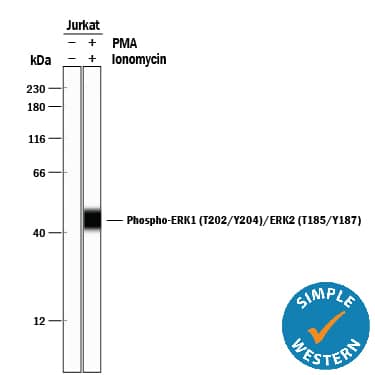 View Larger
View Larger
Detection of Human Phospho-ERK1 (T202/Y204)/ERK2 (T185/Y187) by Simple WesternTM. Simple Western lane view shows lysates of Jurkat human acute T cell leukemia cell line untreated (-) or treated (+) with 200 nM PMA and Ionomycin for 20 minutes, loaded at 0.2 mg/mL. A specific band was detected for Phospho-ERK1 (T202/Y204)/ERK2 (T185/Y187) at approximately 42 kDa (as indicated) using 5 µg/mL of Rabbit Anti-Human/Mouse/Rat Phospho-ERK1/ERK2 (ERK1 T202/Y204, ERK2 T185/Y187) Monoclonal Antibody (Catalog # MAB1018). This experiment was conducted under reducing conditions and using the 12-230 kDa separation system.
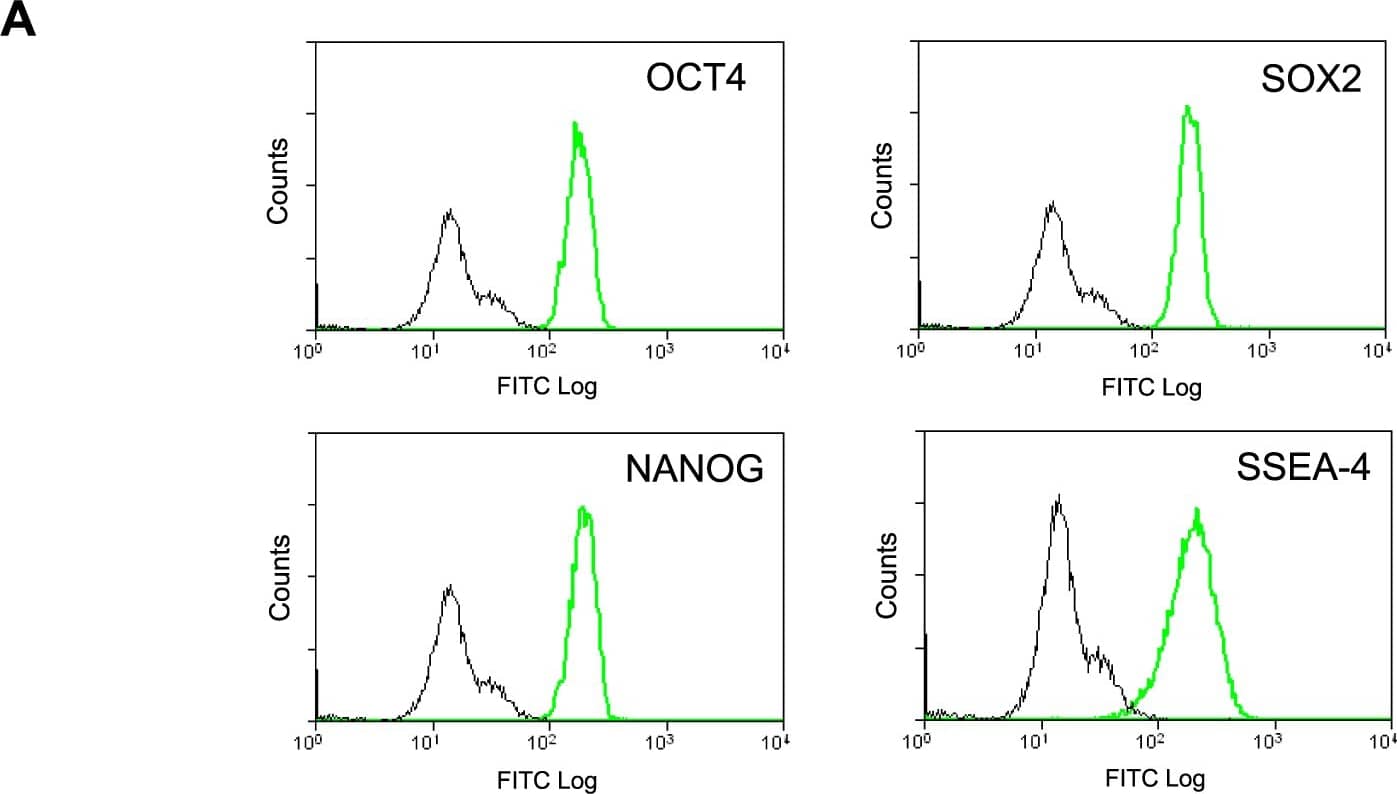 View Larger
View Larger
Detection of Human ERK1/ERK2 by Flow Cytometry Differentiation Characteristics of Individual Stem Cells.(A) Flow cytometric analysis of undifferentiated stem cell markers in the clonal NTERA2.Tom cell line. Black line depicts P3X negative control and green depicts antigen specific expression (OCT4, SOX2, NANOG and SSEA4). (B) Graph depicting the percentage of TUJ1 positive neurons within differentiated colonies derived from individual RA treated NTERA2.Tom stem cells. (C) Images of differentiated NTERA2.Tom colonies derived from individual NTERA2.Tom cells on a background of wildtype NTERA2 cells. Cell were exposed to RA for 21 days (Green - beta III tubulin, Blue - Hoechst) White arrows depict beta III tubulin positive NTERA2.Tom neurons. Scale bar represents 50 µM. Image collected and cropped by CiteAb from the following publication (https://pubmed.ncbi.nlm.nih.gov/20531938), licensed under a CC-BY license. Not internally tested by R&D Systems.
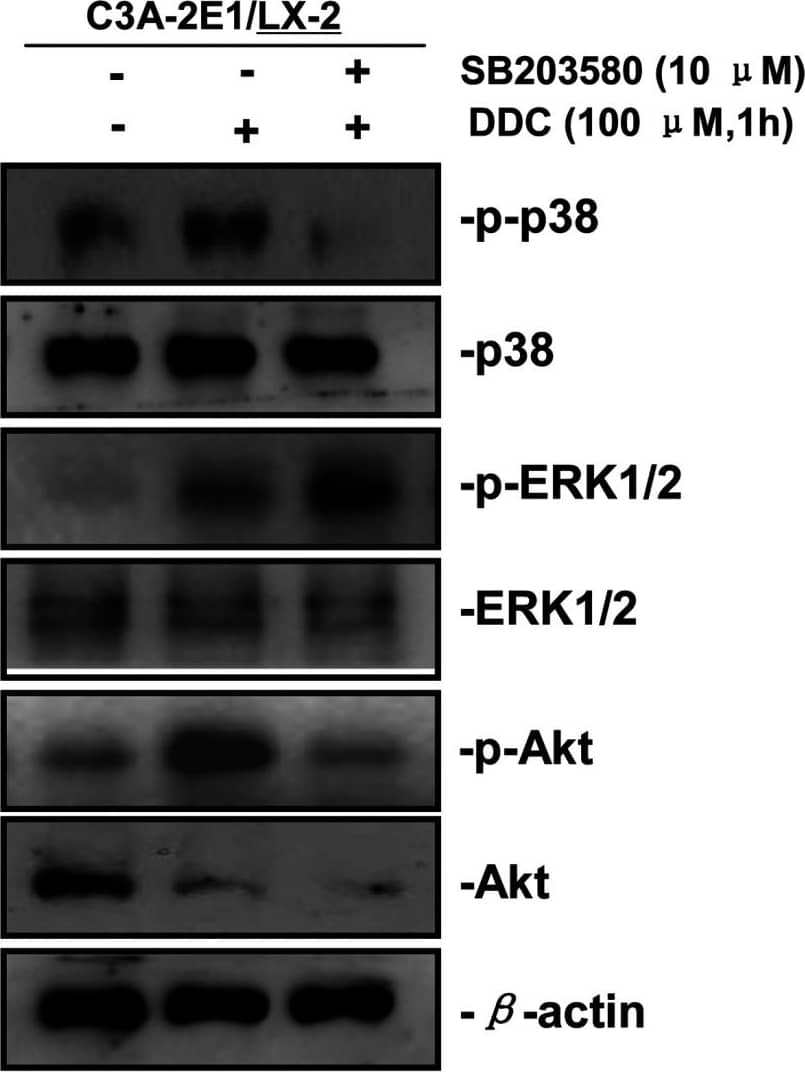 View Larger
View Larger
Detection of Human ERK1/ERK2 by Western Blot p38 inhibitor SB203580 improves the up-regulation of MMP-1 by DDC through stimulating ERK1/2Co-cultures were treated with or without 100 μM DDC for 1 h in the presence or absence of p38 inhibitor (SB203580, 10 μM). Phosphorylation of ERK1/2, p38 and Akt in LX-2 cells of co-cultures were determined by Western blotting analysis. Image collected and cropped by CiteAb from the following publication (https://pubmed.ncbi.nlm.nih.gov/23577625), licensed under a CC-BY license. Not internally tested by R&D Systems.
 View Larger
View Larger
Detection of Human ERK1/ERK2 by Western Blot Phospho-proteome profiling results of LX-2 cells co-cultured with C3A–CYP2E1 cells with or without DDC treatment and detection of the effect of DDC on intracellular kinases in LX-2 cells of co-cultures200 μg of total cell lysates from LX-2 cells co-cultured with C3A-2E1 cells with or without 100 μM DDC for 1 h were incubated with membranes of the human phospho-MAPK Array Kit according to the manufacturer's instructions. Phospho MAPK Array data were developed on X-ray films following exposure to chemiluminescent reagents. 20 μg aliquots of total cell lysates from LX-2 cells were subjected to Western blotting analysis. (A) Template showing the location of MAPK antibodies spotted onto the human phospho-MAPK Array Kit. (B) The activation status of ERK1/2 in LX-2 cells co-cultured with C3A-2E1 cells after DDC treatment. (C) The activation status of p38 in LX-2 cells co-cultured with C3A-2E1 cells after DDC treatment. (D) The activation status of Akt in LX-2 cells co-cultured with C3A-2E1 cells after DDC treatment. (E) The activation status of ERK1/2, p38 and Akt in LX-2 cells co-cultured with C3A cells after DDC treatment. Image collected and cropped by CiteAb from the following publication (https://pubmed.ncbi.nlm.nih.gov/23577625), licensed under a CC-BY license. Not internally tested by R&D Systems.
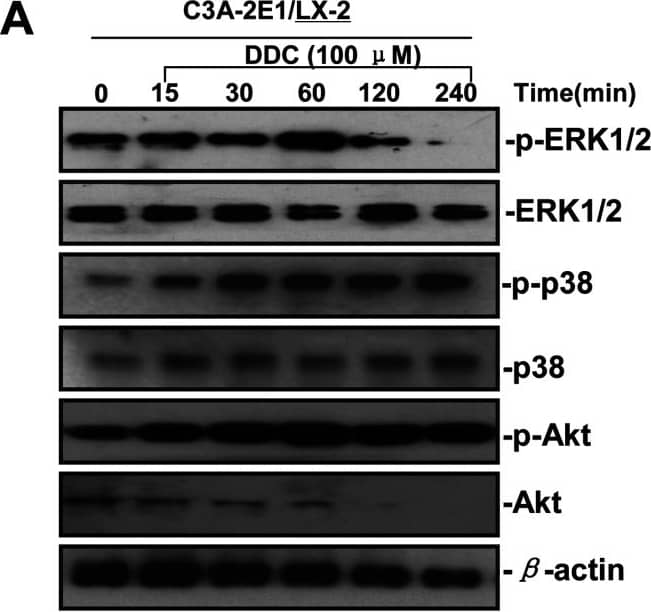 View Larger
View Larger
Detection of Human ERK1/ERK2 by Western Blot DDC up-regulates MMP-1 through ERK1/2 and Akt activation(A) Co-cultures were treated with 100 μM DDC for the indicated time. Phosphorylation of ERK1/2, p38 and Akt were determined by Western blotting analysis. The corresponding non-phosphorylated ERK1/2, p38, Akt and beta -actin were used for protein loading control. (B) Co-cultures were treated with or without 100 μM DDC for 24 h in the presence or absence of ERK1/2 inhibitor (U0126, 10 μM). MMP-1 protein levels were analysed by Western blotting. (C) Co-cultures were treated with or without 100 μM DDC for 24 h in the presence or absence of p38 inhibitor (SB203580, 10 μM). MMP-1 protein levels were analysed by Western blotting. (D) Co-cultures were treated with or without 100 μM DDC for 24 h in the presence or absence of Akt inhibitor (T3830, 50 μM). MMP-1 protein levels were analysed by Western blotting. Image collected and cropped by CiteAb from the following publication (https://pubmed.ncbi.nlm.nih.gov/23577625), licensed under a CC-BY license. Not internally tested by R&D Systems.
 View Larger
View Larger
Detection of Human ERK1/ERK2 by Western Blot Phospho-proteome profiling results of LX-2 cells co-cultured with C3A–CYP2E1 cells with or without DDC treatment and detection of the effect of DDC on intracellular kinases in LX-2 cells of co-cultures200 μg of total cell lysates from LX-2 cells co-cultured with C3A-2E1 cells with or without 100 μM DDC for 1 h were incubated with membranes of the human phospho-MAPK Array Kit according to the manufacturer's instructions. Phospho MAPK Array data were developed on X-ray films following exposure to chemiluminescent reagents. 20 μg aliquots of total cell lysates from LX-2 cells were subjected to Western blotting analysis. (A) Template showing the location of MAPK antibodies spotted onto the human phospho-MAPK Array Kit. (B) The activation status of ERK1/2 in LX-2 cells co-cultured with C3A-2E1 cells after DDC treatment. (C) The activation status of p38 in LX-2 cells co-cultured with C3A-2E1 cells after DDC treatment. (D) The activation status of Akt in LX-2 cells co-cultured with C3A-2E1 cells after DDC treatment. (E) The activation status of ERK1/2, p38 and Akt in LX-2 cells co-cultured with C3A cells after DDC treatment. Image collected and cropped by CiteAb from the following publication (https://pubmed.ncbi.nlm.nih.gov/23577625), licensed under a CC-BY license. Not internally tested by R&D Systems.
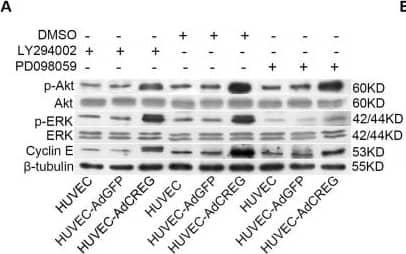 View Larger
View Larger
Detection of Human ERK1/ERK2 by Western Blot ERK, but not PI3K/Akt, mediates the increase of cyclin E induced by CREG overexpression in HUVEC. (A) Expression of p-ERK, ERK, p-Akt, Akt, cyclin E and beta -tubulin was detected by Western blotting in the three groups of cells with LY294002 (50 μM) or PD098059 (20 μM) treatment. Vehicle (DMSO)-treated cells were used as control, and beta -tubulin was used as a loading control; (B,C) Pooled analysis of the levels of Akt (B) and ERK (C) signaling activation accessed by the grayscale ratios of p-Akt/Akt and p-ERK/ERK, respectively. Data are given as the mean ± SD (n = 3). *p < 0.05; **p < 0.01. NS: no significant difference. (D) After normalization to beta -tubulin, the difference in the expression of cyclin E between the HUVEC-AdGFP and HUVEC-AdCREG group was reduced by the treatment of PD098059, but not LY294002. Data are given as the mean ± SD (n = 3). **p < 0.01. NS: no significant difference. Image collected and cropped by CiteAb from the following open publication (https://pubmed.ncbi.nlm.nih.gov/24018888), licensed under a CC-BY license. Not internally tested by R&D Systems.
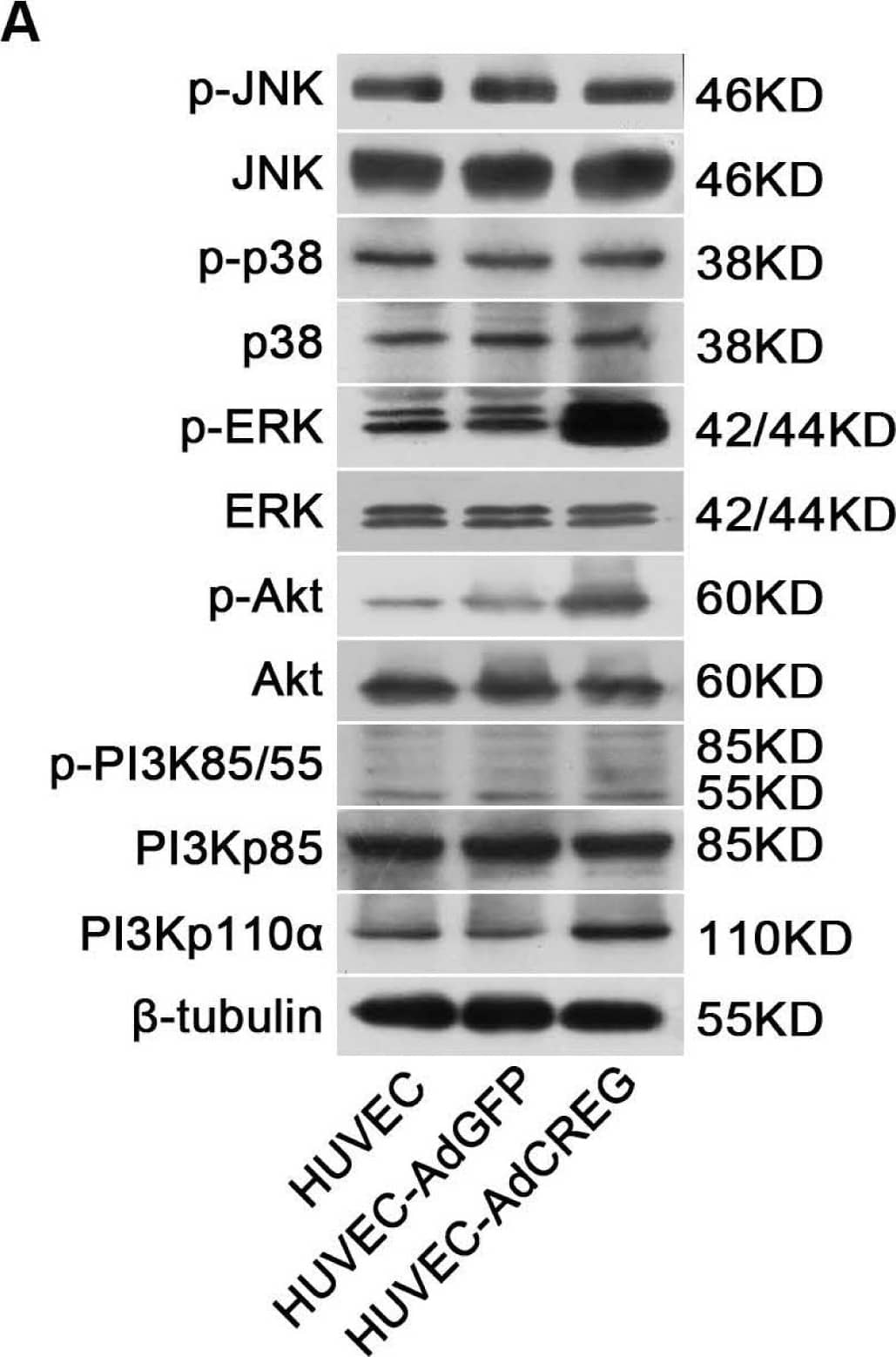 View Larger
View Larger
Detection of Human ERK1/ERK2 by Western Blot CREG overexpression activates both ERK&PI3K/Akt signaling pathways,&ERK, but not PI3K/Akt, mediates CREG effects on HUVEC proliferation. (A) In the three groups of cells (HUVEC, AdGFP&AdCREG), expression of JNK, p38, ERK, PI3K&Akt signaling molecules&their phosphorylated (p-) forms detected by WB, with beta -tubulin as the loading control; Image collected & cropped by CiteAb from the following open publication (https://pubmed.ncbi.nlm.nih.gov/24018888), licensed under a CC-BY license. Not internally tested by R&D Systems.
Reconstitution Calculator
Preparation and Storage
- 12 months from date of receipt, -20 to -70 °C as supplied.
- 1 month, 2 to 8 °C under sterile conditions after reconstitution.
- 6 months, -20 to -70 °C under sterile conditions after reconstitution.
Background: ERK1/ERK2
ERK1 and ERK2 (also known as MAPK3 and MAPK1) are 44- and 42-kDa Ser/Thr kinases, respectively. They are part of the Ras-Raf-ERK signal transduction cascade often found downstream of growth factor receptor activation. ERK1 and ERK2 were initially isolated and cloned as kinases activated in response to insulin and NGF. They are expressed in most, if not all, mammalian tissues. Dual threonine and tyrosine phosphorylation activate both ERKs, at Thr202/Tyr204 for human ERK1 and Thr185/Tyr187 for human ERK2. The two proteins share 83% amino acid identity, differing mainly at the N and C termini.
Product Datasheets
Citations for Human/Mouse/Rat Phospho-ERK1 (T202/Y204)/ERK2 (T185/Y187) Antibody
R&D Systems personnel manually curate a database that contains references using R&D Systems products. The data collected includes not only links to publications in PubMed, but also provides information about sample types, species, and experimental conditions.
21
Citations: Showing 1 - 10
Filter your results:
Filter by:
-
Transcriptional Up-Regulation of FBXW7 by KCa1.1 K+ Channel Inhibition through the Nrf2 Signaling Pathway in Human Prostate Cancer LNCaP Cell Spheroid Model
Authors: Ohya, S;Kito, H;Kajikuri, J;Yamaguchi, Y;Matsui, M;
International journal of molecular sciences
Species: Human
Sample Types: Cell Lysates
Applications: Western Blot -
CD40 Ligand-CD40 Interaction Is an Intermediary between Inflammation and Angiogenesis in Proliferative Diabetic Retinopathy
Authors: Abu El-Asrar, AM;Nawaz, MI;Ahmad, A;Dillemans, L;Siddiquei, M;Allegaert, E;Gikandi, PW;De Hertogh, G;Opdenakker, G;Struyf, S;
International journal of molecular sciences
Species: Human, Rat
Sample Types: Cell Lysates, Tissue Homogenates
Applications: Western Blot -
The proprotein convertase furin regulates the development of thymic epithelial cells to ensure central immune tolerance
Authors: Liang Z, Zhang Z, Zhang Q et al.
iScience
-
Combined anticancer therapy with imidazoacridinone C-1305 and paclitaxel in human lung and colon cancer xenografts-Modulation of tumour angiogenesis
Authors: M ?witalska, B Filip-Psur, M Milczarek, M Psurski, A Moszy?ska, AM D?browska, M Gawro?ska, K Krzymi?ski, M Bagi?ski, R Bartoszews, J Wietrzyk
Oncogene, 2022-06-14;0(0):.
Species: Xenograft
Sample Types: Tissue Homogenates
Applications: Simple Western -
Tissue Inhibitor of Metalloproteinase-3 Ameliorates Diabetes-Induced Retinal Inflammation
Authors: AM Abu El-Asr, A Ahmad, MI Nawaz, MM Siddiquei, A De Zutter, L Vanbrabant, PW Gikandi, G Opdenakker, S Struyf
Frontiers in Physiology, 2022-01-10;12(0):807747.
Species: Rat
Sample Types: Tissue Homogenates
Applications: Western Blot -
CD146/Soluble CD146 Pathway Is a Novel Biomarker of Angiogenesis and Inflammation in Proliferative Diabetic Retinopathy
Authors: AM Abu El-Asr, MI Nawaz, A Ahmad, MM Siddiquei, E Allegaert, PW Gikandi, G De Hertogh, G Opdenakker
Investigative Ophthalmology & Visual Science, 2021-07-01;62(9):32.
Species: Human
Sample Types: Cell Lysates
Applications: Western Blot -
Pharmaceutical immunoglobulin G impairs anti-carcinoma activity of oxaliplatin in colon cancer cells
Authors: Y Shang, X Zhang, L Lu, K Jiang, M Krohn, S Matschos, CS Mullins, B Vollmar, D Zechner, P Gong, M Linnebache
British Journal of Cancer, 2021-02-09;0(0):.
Species: Human
Sample Types: Cell Lysates
Applications: Western Blot -
Evaluation of Proteoforms of the Transmembrane Chemokines CXCL16 and CX3CL1, Their Receptors, and Their Processing Metalloproteinases ADAM10 and ADAM17 in Proliferative Diabetic Retinopathy
Authors: Ahmed M. Abu El-Asrar, Mohd Imtiaz Nawaz, Ajmal Ahmad, Alexandra De Zutter, Mohammad Mairaj Siddiquei, Marfa Blanter et al.
Frontiers in Immunology
-
Safety and Activity of the Combination of Ceritinib and Dasatinib in Osteosarcoma
Authors: O Beck, C Paret, A Russo, J Burhenne, M Fresnais, K Steimel, L Seidmann, DC Wagner, N Vewinger, N Lehmann, M Sprang, N Backes, L Roth, MA Neu, A Wingerter, N Henninger, KE Malki, H Otto, F Alt, A Desuki, T Kindler, J Faber
Cancers (Basel), 2020-03-26;12(4):.
Species: Human
Sample Types: Whole Cells
Applications: Functional Assay -
The Proinflammatory and Proangiogenic Macrophage Migration Inhibitory Factor Is a Potential Regulator in Proliferative Diabetic Retinopathy
Authors: Ahmed M. Abu El-Asrar, Ajmal Ahmad, Mohammad Mairaj Siddiquei, Alexandra De Zutter, Eef Allegaert, Priscilla W. Gikandi et al.
Frontiers in Immunology
-
IGF1R Is a Potential New Therapeutic Target for HGNET-BCOR Brain Tumor Patients
Authors: N Vewinger, S Huprich, L Seidmann, A Russo, F Alt, H Bender, C Sommer, D Samuel, N Lehmann, N Backes, L Roth, PN Harter, K Filipski, J Faber, C Paret
Int J Mol Sci, 2019-06-21;20(12):.
Species: Human
Sample Types: Cell Lysates
Applications: Western Blot -
Propranolol regulates ERK1/2 signaling pathway and promotes chronic wound healing in diabetic rats
Authors: X Chang, S Li, XD Xue, F Chang
Eur Rev Med Pharmacol Sci, 2019-05-01;23(10):4498-4506.
Species: Rat
Sample Types: Cell Lysates
Applications: Western Blot -
Chronic irradiation with low-dose-rate 137Cs-gamma rays inhibits NGF-induced neurite extension of PC12 cells via Ca2+/calmodulin-dependent kinase II activation
Authors: Katoh Shinsuke, Kobayashi Junya, Umeda Tomonobu, Kobayashi Yoshiko, Nobuo Izumo, Suzuki Takahiko
Journal of Radiation Research
-
Beta 1-integrin-c-Met cooperation reveals an inside-in survival signalling on autophagy-related endomembranes
Authors: Rachel Barrow-McG
Nat Commun, 2016-06-23;7(0):11942.
Species: Human, Mouse
Sample Types: Cell Lysates, Whole Cells
Applications: Flow Cytometry, IHC-Fr, Western Blot -
The Proinflammatory Cytokine High-Mobility Group Box-1 Mediates Retinal Neuropathy Induced by Diabetes
Authors: Ahmed M. Abu El-Asrar, Mohammad Mairaj Mairaj Siddiquei, Mohd Imtiaz Nawaz, Karel Geboes, Ghulam Mohammad
Mediators of Inflammation
-
T cell Ig and mucin domain-containing protein 3 is recruited to the immune synapse, disrupts stable synapse formation, and associates with receptor phosphatases.
Authors: Clayton K, Haaland M, Douglas-Vail M, Mujib S, Chew G, Ndhlovu L, Ostrowski M
J Immunol, 2013-12-13;192(2):782-91.
Species: Mouse
Sample Types: Whole Cells
Applications: ICC -
Annexin A10 in human oral cancer: biomarker for tumoral growth via G1/S transition by targeting MAPK signaling pathways.
Authors: Shimizu T, Kasamatsu A, Yamamoto A, Koike K, Ishige S, Takatori H, Sakamoto Y, Ogawara K, Shiiba M, Tanzawa H, Uzawa K
PLoS ONE, 2012-09-17;7(9):e45510.
Species: Human
Sample Types: Cell Lysates
Applications: Western Blot -
The myeloperoxidase-derived oxidant HOSCN inhibits protein tyrosine phosphatases and modulates cell signalling via the mitogen-activated protein kinase (MAPK) pathway in macrophages.
Authors: Lane AE, Tan JT, Hawkins CL
Biochem. J., 2010-08-15;430(1):161-9.
Species: Mouse
Sample Types: Cell Lysates
Applications: Western Blot -
Prepatterning in the Stem Cell Compartment
Authors: Peter D. Tonge, Victor Olariu, Daniel Coca, Visakan Kadirkamanathan, Kelly E. Burrell, Stephen A. Billings et al.
PLoS ONE
-
Cellular repressor of E1A-stimulated genes inhibits human vascular smooth muscle cell apoptosis via blocking P38/JNK MAP kinase activation.
Authors: Han Y, Wu G, Deng J, Tao J, Guo L, Tian X, Kang J, Zhang X, Yan C
J. Mol. Cell. Cardiol., 2010-01-06;48(6):1225-35.
Species: Human
Sample Types: Cell Lysates
Applications: Western Blot -
The involvement of the fractalkine receptor in the transmigration of neuroblastoma cells through bone-marrow endothelial cells.
Authors: Nevo I, Sagi-Assif O, Meshel T, Ben-Baruch A, Johrer K, Greil R, Trejo LE, Kharenko O, Feinmesser M, Yron I, Witz IP
Cancer Lett., 2008-09-07;273(1):127-39.
Species: Human
Sample Types: Cell Lysates
Applications: Western Blot
FAQs
No product specific FAQs exist for this product, however you may
View all Antibody FAQsReviews for Human/Mouse/Rat Phospho-ERK1 (T202/Y204)/ERK2 (T185/Y187) Antibody
Average Rating: 5 (Based on 2 Reviews)
Have you used Human/Mouse/Rat Phospho-ERK1 (T202/Y204)/ERK2 (T185/Y187) Antibody?
Submit a review and receive an Amazon gift card.
$25/€18/£15/$25CAN/¥75 Yuan/¥2500 Yen for a review with an image
$10/€7/£6/$10 CAD/¥70 Yuan/¥1110 Yen for a review without an image
Filter by:



















